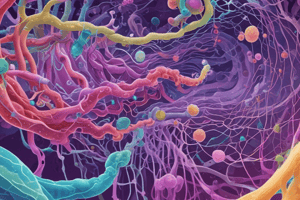Podcast
Questions and Answers
What is the main function of teichoic acids in the peptidoglycan cell wall?
What is the main function of teichoic acids in the peptidoglycan cell wall?
- To synthesize proteins
- To provide strength and shape to the cell
- To prevent osmotic lysis
- To maintain the cell wall's structure (correct)
Which type of bacteria has a cell wall that is absent?
Which type of bacteria has a cell wall that is absent?
- Mycoplasma bacteria (correct)
- Archaea
- Gram-negative bacteria
- Gram-positive bacteria
What is the primary component of the peptidoglycan cell wall in Gram-positive bacteria?
What is the primary component of the peptidoglycan cell wall in Gram-positive bacteria?
- Peptidoglycan (correct)
- Glycoproteins
- Lipopolysaccharides
- Pseudopeptidoglycan
What is the characteristic of the Gram-negative cell wall?
What is the characteristic of the Gram-negative cell wall?
What is the unique component of the Archaeal cell wall?
What is the unique component of the Archaeal cell wall?
What is the function of the periplasmic space in Gram-negative bacteria?
What is the function of the periplasmic space in Gram-negative bacteria?
Flashcards are hidden until you start studying
Study Notes
Cell Wall Structure of Kingdom Monera
Peptidoglycan (Murein) Cell Wall
- Present in most bacteria, including Gram-positive and some Gram-negative bacteria
- Composed of:
- Peptidoglycan (also known as murein): a thick, rigid layer of sugars and amino acids
- Teichoic acids: negatively charged molecules that help maintain the cell wall's structure
- Provides strength, shape, and protection to the cell
- Prevents osmotic lysis by maintaining internal pressure
Gram-Negative Cell Wall
- Found in some Gram-negative bacteria
- Thinner and more complex than Gram-positive cell walls
- Composed of:
- Outer membrane: a lipid bilayer containing lipopolysaccharides and proteins
- Peptidoglycan layer: thinner than in Gram-positive bacteria
- Periplasmic space: a region between the outer membrane and peptidoglycan layer
- Less rigid than Gram-positive cell walls, but still provides protection and maintains cell shape
Mycoplasma Cell Wall
- Absent in Mycoplasma bacteria, a group of bacteria in the kingdom Monera
- Instead, they have a plasma membrane that provides structural support
- Allows for greater flexibility and ability to change shape
Archaeal Cell Wall
- Found in some Archaea, a group of prokaryotes in the kingdom Monera
- Composed of:
- Pseudopeptidoglycan (pseudomurein): a modified form of peptidoglycan
- Glycoproteins: proteins with carbohydrate molecules attached
- Other unique compounds, such as methanochondroitin
- Provides structural support and protection to the cell
Cell Wall Structure of Kingdom Monera
Peptidoglycan (Murein) Cell Wall
- Found in most bacteria, including Gram-positive and some Gram-negative bacteria
- Composed of peptidoglycan (murein) and teichoic acids
- Provides strength, shape, and protection to the cell
- Prevents osmotic lysis by maintaining internal pressure
Gram-Negative Cell Wall
- Found in some Gram-negative bacteria
- Thinner and more complex than Gram-positive cell walls
- Composed of outer membrane, peptidoglycan layer, and periplasmic space
- Less rigid than Gram-positive cell walls, but still provides protection and maintains cell shape
Mycoplasma Cell Wall
- Absent in Mycoplasma bacteria
- Replaced by a plasma membrane that provides structural support
- Allows for greater flexibility and ability to change shape
Archaeal Cell Wall
- Found in some Archaea
- Composed of pseudopeptidoglycan (pseudomurein), glycoproteins, and other unique compounds
- Provides structural support and protection to the cell
Studying That Suits You
Use AI to generate personalized quizzes and flashcards to suit your learning preferences.




